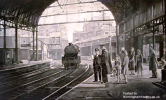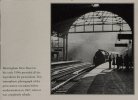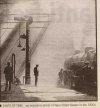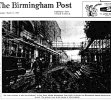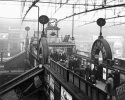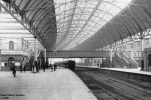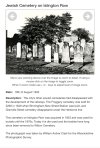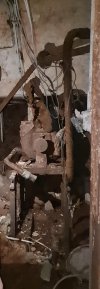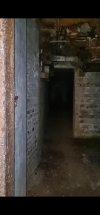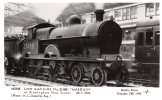-
Welcome to this forum . We are a worldwide group with a common interest in Birmingham and its history. While here, please follow a few simple rules. We ask that you respect other members, thank those who have helped you and please keep your contributions on-topic with the thread.
We do hope you enjoy your visit. BHF Admin Team
You are using an out of date browser. It may not display this or other websites correctly.
You should upgrade or use an alternative browser.
You should upgrade or use an alternative browser.
New Street Station From 1854 - 1966
- Thread starter Di.Poppitt
- Start date
Here is a train entering platform 10 in June 1962, showing some of the station buildings .
View attachment 169818
Here's an old print of New Street Station, that hangs on the wall next to my desk in the corner of our living room, along with the inset information.
Martin
Attachments
According to warwickshirerailways.com the photo shows LMS 2-6-0 'Horwich Crab' at the east end of platform 1 New Street Station. Date is given as c.1928. Photographer: Arthur W Flowers.Old Paper Cutting, might have been posted beforeView attachment 171454
Last edited:
Radiorails
master brummie
There are photos here showing the earlier station, Midland and LNWR, and Queens Drive.
Heartland
master brummie
Birmingham New Street was originally two stations in one separated by Queen's Drive
Not strictly true, the Midland Railway built the one side of Queen Drive, but New Street station as a whole was classed as a "joint station" after the Midland Railway side was made and there was a joint station master.
The original station was effectively owned and built for the London & North Western Railway, but Midland Railway trains came to use it after their tenancy at Curzon Street ended. It was also, for a time, used by the Shrewsbury & Birmingham Railway and the South Staffordshire Railway companies. In the first years of it's existence the name Grand Central was applied to this original station.
With Grouping of 1921-23 New Street became the responsibility of the LMS and then BR. It was BR that reconstructed the station as part of the Electrification Scheme Liverpool & Manchester- London. It was Network Rail that were responsible for the modern make over, which led to the name Grand Central being applied to the shopping centre and the Metro Stop.
During 2022 the station signs also mentioned the Commonwealth Games which ended last Monday.
As to Station signage one perhaps that needs to be taken to task is Birmingham International which now has platform name boards "Birmingham Int"
What does the "Int" stand for apart from International
Interred
Interstellar
Interstratify
Interval
The list could go on, With Interval it may be appropriate as the next stage will be to build a HS 2 Station and an autonomous people mover which will have an intermediate stop for the NEC and a stop at the Airport, but will it serve the INT station as well ?
Not strictly true, the Midland Railway built the one side of Queen Drive, but New Street station as a whole was classed as a "joint station" after the Midland Railway side was made and there was a joint station master.
The original station was effectively owned and built for the London & North Western Railway, but Midland Railway trains came to use it after their tenancy at Curzon Street ended. It was also, for a time, used by the Shrewsbury & Birmingham Railway and the South Staffordshire Railway companies. In the first years of it's existence the name Grand Central was applied to this original station.
With Grouping of 1921-23 New Street became the responsibility of the LMS and then BR. It was BR that reconstructed the station as part of the Electrification Scheme Liverpool & Manchester- London. It was Network Rail that were responsible for the modern make over, which led to the name Grand Central being applied to the shopping centre and the Metro Stop.
During 2022 the station signs also mentioned the Commonwealth Games which ended last Monday.
As to Station signage one perhaps that needs to be taken to task is Birmingham International which now has platform name boards "Birmingham Int"
What does the "Int" stand for apart from International
Interred
Interstellar
Interstratify
Interval
The list could go on, With Interval it may be appropriate as the next stage will be to build a HS 2 Station and an autonomous people mover which will have an intermediate stop for the NEC and a stop at the Airport, but will it serve the INT station as well ?
Just to avoid any confusion this is from Wiki
New Street station was built in central Birmingham by the London and North Western Railway (LNWR) between 1846 and 1854, on the site of several streets in a marshy area known as "The Froggery"; it replaced several earlier rail termini on the outskirts of the centre, most notably Curzon Street, which had opened in 1838 and was no longer adequate for the level of traffic.[6] Samuel Carter, solicitor to both LNWR and the Midland Railway, managed the conveyancing.
Until 1885, the LNWR shared the station with the Midland; however, in 1885, the Midland Railway opened its own extension alongside the original station for the exclusive use of its trains, effectively creating two stations side by side. The two companies' stations were separated by a central roadway, Queens Drive. [6] Traffic grew steadily and, by 1900, New Street had an average of 40 trains an hour departing and arriving, rising to 53 trains in the peak hours.[7]
New Street station was built in central Birmingham by the London and North Western Railway (LNWR) between 1846 and 1854, on the site of several streets in a marshy area known as "The Froggery"; it replaced several earlier rail termini on the outskirts of the centre, most notably Curzon Street, which had opened in 1838 and was no longer adequate for the level of traffic.[6] Samuel Carter, solicitor to both LNWR and the Midland Railway, managed the conveyancing.
Until 1885, the LNWR shared the station with the Midland; however, in 1885, the Midland Railway opened its own extension alongside the original station for the exclusive use of its trains, effectively creating two stations side by side. The two companies' stations were separated by a central roadway, Queens Drive. [6] Traffic grew steadily and, by 1900, New Street had an average of 40 trains an hour departing and arriving, rising to 53 trains in the peak hours.[7]
Richard Dye
master brummie
Love those Birmingham stations!
mw0njm.
A Brummie Dude
Love those Birmingham stations!
me too i loved all of them stations in the steam era,they changed when the d d d diesels came that name got stuck in my throat
devonjim
master brummie
It was like this until mid 1960's wasn't it? Looks familiar to me.I really like this 1927 view of passengers crossing the bridge. Must have been interesting getting a closer view of enormous arched roof. Wonder who the policeman was on the lookout for ? Are the levers around the clock for changing the tracks, like those of a signal box ? Viv.
View attachment 173395
Lloyd
master brummie
Yes, it was the station signal box Viv. There are more levers on the left hand side of that 'platform in the air' (smoke!). The arched roof was destroyed in the WW2 blitz.Are the levers around the clock for changing the tracks, like those of a signal box ? Viv.
hi just doing a bit of research and i wonder if anyone can confirm that apart from the froggery was the station also built on a jewish burial ground...thanks folks for any help givenJust to avoid any confusion this is from Wiki
New Street station was built in central Birmingham by the London and North Western Railway (LNWR) between 1846 and 1854, on the site of several streets in a marshy area known as "The Froggery"; it replaced several earlier rail termini on the outskirts of the centre, most notably Curzon Street, which had opened in 1838 and was no longer adequate for the level of traffic.[6] Samuel Carter, solicitor to both LNWR and the Midland Railway, managed the conveyancing.
Until 1885, the LNWR shared the station with the Midland; however, in 1885, the Midland Railway opened its own extension alongside the original station for the exclusive use of its trains, effectively creating two stations side by side. The two companies' stations were separated by a central roadway, Queens Drive. [6] Traffic grew steadily and, by 1900, New Street had an average of 40 trains an hour departing and arriving, rising to 53 trains in the peak hours.[7]
lyn
We seem to have multiple threads for the 1850s station so maybe a mod could move the posts in this thread to the existing one below please ? Many thanks Viv
 birminghamhistory.co.uk
birminghamhistory.co.uk
New Street Station From1854
Birmingham New Street's famous footbridge, refurbished after the war, showing the section spanning Queen's Drive, which still had its mid-section canopy at this time, 13th April 1960. (1997) A century of railways around Birmingham and the West Midlands : a personal selection. Vol. 2. Great...
 birminghamhistory.co.uk
birminghamhistory.co.uk
See post #6 and #7 here Lyn. Viv.
 birminghamhistory.co.uk
birminghamhistory.co.uk
Disinterment and reinterments at Birmingham burial grounds
In this thread I intend to record any Birmingham disinterment and reinterment of human remains. I shall give brief details, an example of a report and give reference to the general thread about the place of worship and it’s burial ground. This may be of help to those researching the whereabouts...
 birminghamhistory.co.uk
birminghamhistory.co.uk
This is a quote from Chris Upton's 'History of Birmingham' (1993, p102):hi just doing a bit of research and i wonder if anyone can confirm that apart from the froggery was the station also built on a jewish burial ground...thanks folks for any help given
lyn
"Hebrew cemeteries in Granville Street and Betholom Row (off Bath Row) were rendered unusable by the cutting of railway lines through or near them. The bodies from Granville Street were transferred to the new Hebrew cemetery at Witton; Betholom Row (which opened in 1823) remained in use for non-Birmingham Jews and indeed part of the burial ground still survives."
No mention that the station itself was built over a Hebrew burial ground.
Last edited:
There were 20-30 burials at the Froggery, these being removed to Granville Street C1840s. These were again disinterred in the 1870s from Granville Street to Witton Cemetery.
Viv.
Viv.



